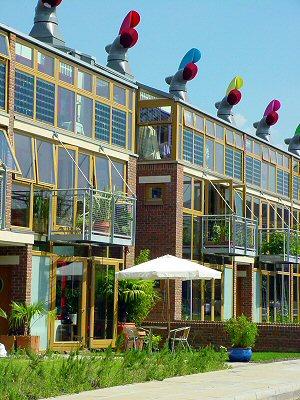In 1987, the Bruntland Report, on economic development and the environment, defined sustainable development as - ‘development that meets the needs of the present without compromising the ability of future generations to meet their own needs’
 Code for Sustainable Homes
Code for Sustainable Homes
In December 2006, the UK government launched the Code for Sustainable Homes. The Code is a development guide for home designers and builders, and the national standard for the building of sustainable homes.
Code for Sustainable Homes - Lower Energy Use
It is anticipated that the Code for Sustainable Homes will reduce the environmental impact of the construction sector as whole and will form the basis for future Building Regulations. The Government wants to see homes built in a way that minimises the use of energy and reduces harmful carbon dioxide emissions but, more importantly, it adds -
‘We also need to build and use our homes in a way that minimises their other environmental impacts, such as the water use, the waste they generate, and the materials they are built from’
Sustainable Homes Assessment and Rating System
It comprises an assessment and rating system aimed at improving the environmental impact of new homes by introducing minimum standards in nine areas, including the use of energy, carbon dioxide and water.
Code for Sustainable Homes - Key Categories
The Code for Sustainable Homes goes beyond the current building regulations in taking a ‘whole house’ approach to house construction and its impact on the environment. The key design categories incorporated within the code are:
- Energy and Carbon Dioxide Emissions– Operational Energy and the resulting emissions of carbon dioxide to the atmosphere
- Water – the consumption of potable water from the public supply system or other ground water resources
- Materials – the embodied environmental impacts of construction materials for key construction elements
- Surface Water Run-off – the change in surface water runoff patterns as a result of the development.
- Waste – waste generated as a result of the construction process and facilities encouraging the recycling of domestic waste in the home
- Pollution – pollution resulting from the operation of the dwelling
- Health and Well being – the effect that the dwelling’s design and indoor environment has on its occupants
- Management – steps that have been taken to allow management of environmental impacts in the construction and operation of the home
- Ecology – the impact of the dwelling on the local eco-system, biodiversity and land use to achieve any of the Code’s ratings it will be necessary to meet the requirements covering a number of these parameters
 Code for Sustainable Homes - Sustainability Rating
Code for Sustainable Homes - Sustainability Rating
The sustainability rating which a home achieves represents its overall performance across the nine Code design categories. Minimum standards exist for a number of categories. These must be achieved to gain a one star sustainability rating. Energy efficiency and Water efficiency categories also have minimum standards that must be achieved at every level of the Code for Sustainable Homes, recognising their importance to the sustainability of any home. Apart from the minimum requirements, the Code for Sustainable Homes is completely flexible; developers can choose which and how many standards they implement to obtain the ‘points’ under the Code in order to achieve a higher sustainability rating.
Code for Sustainable Homes Star Rating System
The Code for Sustainable Homes uses a sustainable rating system indicated by ‘stars’ to communicate the overall sustainability performance of a home. A home can achieve a rating from one to six stars, depending on the extent to which it has achieved code standards.
The Code for Sustainable Homes is progressively introducing the star rating system from 2006 to 2016. Ratings run from the minimum of 1 Star, where a house is 10 per cent more efficient than that required by the 2006 Building Regulations standard, to a completely zero carbon home which is rated as 6 Stars. Designers are required to achieve increasingly stringent criteria to reach each level of the code's requirements.
The points system integrates energy and water usage as well as other key sustainability criteria. The timetable for the introduction of the ratings is:
2008 - It was mandatory for the Public Sector to achieve a Level 3 rating and the Private Sector must achieve a mandatory Code rating
2010 - It is mandatory for the Public Sector to achieve a Level 4 rating and the Private Sector must achieve a mandatory Level 3 rating
2013 - It will be mandatory for the Public Sector to achieve a Level 6 rating and the Private Sector must achieve a mandatory Level 4 rating
2016 - It will be mandatory for the Public Sector to achieve a Level 6 rating and the Private Sector must achieve a mandatory Level 6 rating
Code for Sustainable Homes Measurement Criteria and Practical Examples
The measurement criteria are set out in the Code for Sustainable Homes, together with practical examples of the standards required to meet the Code levels.
Code for Sustainable Homes Assessment Procedure
Code assessments are carried out in two stages. The first assessment is carried out at the design stage and the second after the construction of the dwelling when the final code certificate is issued.
Code for Sustainable Homes Formal Assessment
Formal assessment of dwellings using the Code for Sustainable Homes may only be carried out using licensed and registered individuals who are qualified ‘competent persons’ for the purpose of carrying out the Code assessments.
The Code for Sustainable Homes is available on-line on the Department for Communities and Local Government website.
Link to - Communities.gov.uk








